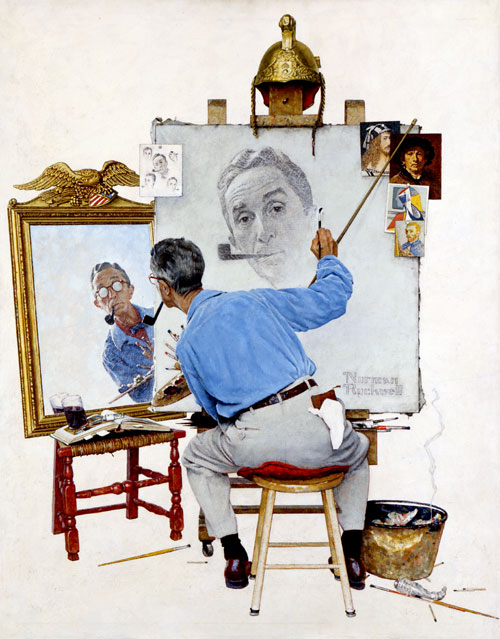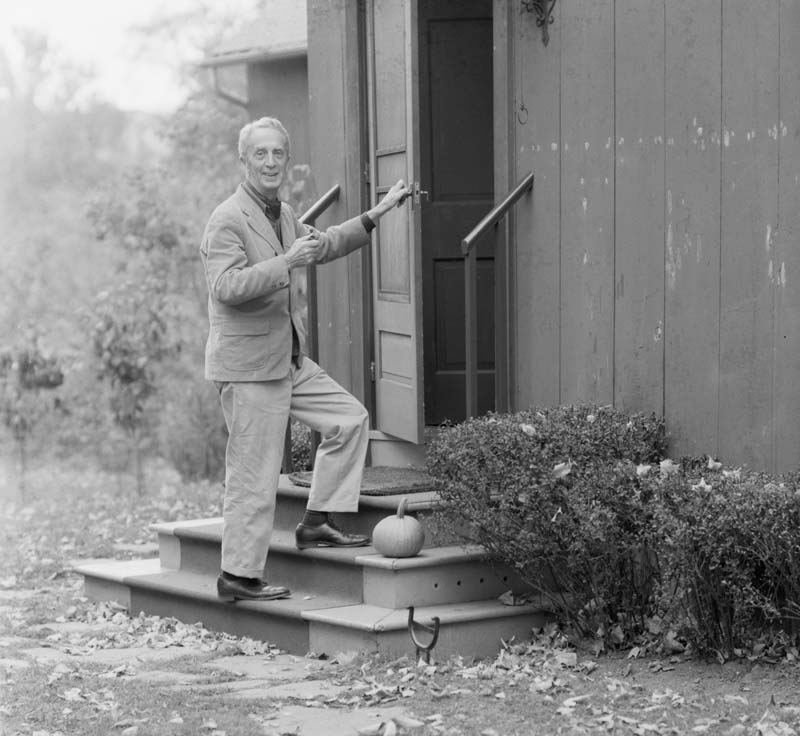Meet Norman Rockwell, American Illustrator
Overview:
This lesson will introduce students to Norman Rockwell, a professional artist and illustrator who had been inspired by the daily events in his everyday life in America. Images from books, the internet, written articles and a group discussion will be used to demonstrate how the American culture influenced Norman Rockwell in communicating his ideas as visual narratives.
This lesson is designed for one or two 20 minute class periods.
Enduring Understandings/ Essential Questions:
- Norman Rockwell is a well-known, famous American illustrator.
- Illustrators are visual storytellers; they are artists and create pictures to tell a story.
- Rockwell’s paintings show what American life was like from the early 1900’s to the 1970’s. His paintings progress from the portrayal of ordinary, everyday events to social inequalities.
- We can learn about Norman Rockwell by reading books, talking about and looking at artwork. We can see authentic pieces of art created by Rockwell at museums, studying his paintings and visiting websites that have information about him.
- Norman Rockwell was inspired by his surroundings (nature, politics but also ordinary events of his friends and neighbors.)
- Who is Norman Rockwell?
- What is an illustrator?
- What was the subject of Norman Rockwell’s artwork? What was he telling a story about in his paintings?
- How might you learn more about Norman Rockwell?
- What things influenced Norman Rockwell’s work?
- Grade
- K-1
- Theme
- Four Freedoms
- Length
- This lesson is designed for one or two 20 minute class periods.
- Discipline
- National Standards for Visual Arts
- Vocabulary
- Advertisements; Art critics; Art Director; Book publishers; Boy Scouts; Charles Dickens; Culture; Familiar; Golden Age of Illustration; Illustrator; Museums; Saturday Evening Post; Self-Portrait; Symbol
Objectives:
- Students will share any prior knowledge regarding Norman Rockwell that they may have.
- Students will discuss the information presented in text(s) about Norman Rockwell and selected illustrations painted by Norman Rockwell.
- Using prior knowledge, the information from the book(s) and internet resources, the students will tell about Norman Rockwell, his paintings and the stories illustrated in the paintings.
- Students will listen attentively to one another as they share personal responses about the specific artworks.
Background:
Norman Rockwell was born in New York City in 1894. He was a super-skinny kid and was terrible at sports, but he always knew that he wanted to be an artist. His paintings would tell a story without words. His work was influenced by family, friends, neighbors and vacations. He worked for more than sixty years painting scenes of people in their everyday life.
Rockwell was a teenager when he was hired to work as the art director of Boys’ Life, the official magazine of the Boy Scouts of America. In this job, Rockwell had to make all of the decisions about how the magazine should look. When he was 22 years old, Rockwell painted his first cover for a popular American magazine, The Saturday Evening Post, and continued to paint 323 covers over the next 47 years.
In 1916, the same year his work was on the cover of The Saturday Evening Post, Rockwell married Irene O’Connor. Their marriage lasted 14 years, then they divorced. In 1930 he married a teacher, Mary Barstow. Norman and Mary Rockwell had three sons, Jarvis, Thomas, and Peter. Nine years after they were married, the family moved to the small town of Arlington, Vermont. The community of people in Arlington were supportive of Norman Rockwell and his work. Their neighbors and friends were often eager to be models for his work.
In 1943, President Franklin Roosevelt’s spoke to the American people in a speech called “The Four Freedoms.” Norman Rockwell felt the President’s message was important and wanted to illustrate it. The Four Freedoms paintings were Norman Rockwell’s interpretations of the Freedom of Speech, Freedom to Worship, Freedom from Want, and Freedom from Fear. These four paintings became tremendously popular.
The Rockwell family moved to Stockbridge, Massachusetts in 1953. Sadly, six years later his wife, Mary, died unexpectedly. Shortly after, Rockwell met a retired teacher, Molly Punderson, at the library and they became close friends and eventually married. It was at this time that Rockwell began to paint pictures illustrating some of his most worrisome concerns and deepest interests, including civil rights, poverty, and the exploration of space.
In 1977, the President presented Rockwell with the nation’s highest civilian honor, the Presidential Medal of Freedom! Rockwell became one of America’s all-time favorite artists before he died in 1978.
Materials:
Multimedia Resources
Triple Self Portrait
Norman Rockwell
American Chronices: The Art of Norman Rockwell
Norman Rockwell Museum
Classroom Supplies:
- Getting to Know the World’s Greatest Artist: Norman Rockwell by Mike Venezia
- Paper
Additional Teaching Resources:
The Norman Rockwell Museum at Stockbridge by The Norman Rockwell Museum
Norman Rockwell, My Adventures as an Illustrator by Norman Rockwell
Norman Rockwell: Behind the Camera by Ron Schick
Norman Rockwell’s America by Christopher Finch
Norman Rockwell’s Four Freedoms: Images that Inspire a Nation by Stuart Murray and James McCabe
American Chronicles: The Art of Norman Rockwell by Linda Szekely Pero
Norman Rockwell’s Counting Book by Gloria Tabor
Norman Rockwell: Storytelling with a Brush by Beverly Sherman
My Adventures as an Illustrator by Norman Rockwell
A Rockwell Portrait: An Intimate Biography by Donald Walton
Enduring Ideals: Rockwell, Roosevelt & the Four Freedoms, edited by Stephanie Haboush Plunkett and James J. Kimble
Activities:
- Ask the students to listen attentively to one another as they share personal responses throughout the lesson.
- Read Getting to Know the World’s Greatest Artists: Norman Rockwell by Mike Venezia to the students, pausing to reinforce information and allowing for questions to be asked when something is unclear.
- Show the students Norman Rockwell’s Triple Self Portrait and ask the students to respectfully share with the group what they see in the image. The class will collectively take a visual inventory. As each student contributes, restate their observation. You might be able to elaborate on what they have said to add more visual detail or you might ask them for clarification. You might encourage them to look more closely and carefully.
- Ask the students to think about themselves and what objects they would include in their own self-portrait to help show others who they are as individuals. Distribute paper and ask each student to draw their own self portrait including at least one symbol about themselves.
Assessment:
- Students will be evaluated on demonstrating appropriate listening and speaking skills during their participation in the group discussion.
- Students will be evaluated on their participation in analyzing the text read to them.
- Students will be evaluated on their participation in analyzing the visual imagery through informal checks of understandings.
Standards
This curriculum meets the standards listed below. Look for more details on these standards please visit: ELA and Math Standards, Social Studies Standards, Visual Arts Standards.
- VA:Cn11.1.1
- Understand that people from different places and times have made art for a variety of reasons.
- VA:Re7.2.1
- Compare images that represent the same subject.
- VA:Re7.2.K
- Describe what an image represents.
- VA:Re8.1.1
- Interpret art by categorizing subject matter and identifying the characteristics of form.
- VA:Re8.1.K
- Interpret art by identifying subject matter and describing relevant details.

